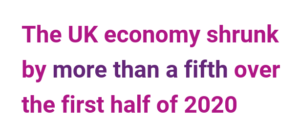Though there has been a seemingly endless cycle of bad news and portraits of businesses failing and people suffering both financial and business hardships throughout these challenging times, the numbers tell a slightly different story with data identifying the emergence of unexpected patterns. One such pattern suggests that the number of businesses that are failing and the dissolutions which have occurred since the onset of the lockdown over the last six months is significantly less than those that occurred in 2019. In fact, in 2019, 110,000 more businesses failed during the same period versus 2020.
One such pattern suggests that the number of businesses that are failing and the dissolutions which have occurred since the onset of the lockdown over the last six months is significantly less than those that occurred in 2019. In fact, in 2019, 110,000 more businesses failed during the same period versus 2020.
However, there has been a 500% spike in lending volumes when you look from May through to July, which is the consequence of the different government initiatives to support and save small businesses.
Another look at the data shows the number of companies that have been incorporated in 2020 has surpassed the number of companies that were incorporated in 2019 for the same period, which is discussed further below.
Where lenders are concerned, the impact of Covid-19 and the intervention measures that surround it such as Coronavirus business interruption loan scheme (CBILS), Bounce Back Loan Scheme (BBLS) and furlough, are the most crucial catalysts to consider.
Then BBLS landed, a saving grace for a lot of businesses and people, who by this stage were desperate just to keep the lights on. The numbers indicate the take up of BBLS was crucial in keeping the economy moving.
CBILS and BBLS have supported 1.2 million businesses with banks having lent £50 billion. However, these unprecedented lending levels mean there is a lot of bad debt lurking further downstream.
The fact that there have been fewer dissolutions of businesses this year when comparing the same period in 2019, means it is likely that there are a significant number of businesses that would have failed if these schemes were not in place. For example, several businesses would have failed if Covid-19 had not happened.

These zombie companies have continued to increase in number and become more prolific in the market. Comparing 2008 to now, when there was no support implemented to rescue such businesses and keep them going, meaning we’re likely to see an increase in business failure rates in the months to come.
What does this mean for lenders?
When BBLS was launched, there was a sudden leap in the number of business accounts opening up throughout the UK, which is often a red flag for lenders. Albeit, a percentage of these were non-limited companies, but this highlights the real risk of fraud within those BBLS claimants. In addition to this, 13% of businesses sustained by BBLS were already in the high-risk category from a credit perspective, would they have been granted funding if there was no pandemic?
Businesses and people are facing challenging times and therefore lenders may need to closely monitor and review the levels of risk throughout their books.
How can lenders mitigate risk?
Lenders can mitigate risk by employing an array of strategies and tools when managing their portfolios:
Strategies and tools to help mitigate risk
-Ensure robust customer checks to help prevent fraud
-Prioritise portfolio monitoring
-Use full suite of data to gain a 360 degree view of customers
-Identify businesses most at risk of default
-Understand affordability of business customers
-Overlay economic insight and foresight to determine which businesses are likely to bounce back
-Apply short and long term risk forecasting
Protecting your commercial lending portfolio in both the long term and short term during fast-changing times is a balancing act which entails spreading risk as much as possible while knowing there is only finite support to look at every business on a regular basis.
Here at Experian, we’re committed to sharing our data and insights to help you understand the changing landscape and where your concentrations of risk are, as well as unearth new trends. We are in the unique and unrivalled position of being able to overlay economic foresight onto credit insights to get both a back and forward-looking view – and our innovation agenda is committed to developing tools which can help you and your customers thrive, even in these uncertain times. To find out more please contact us
